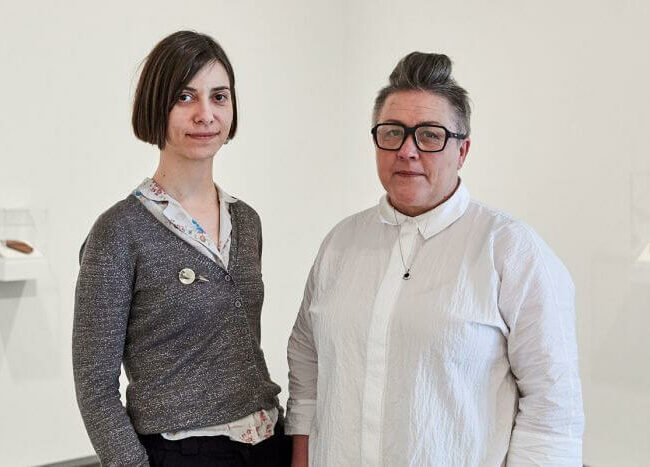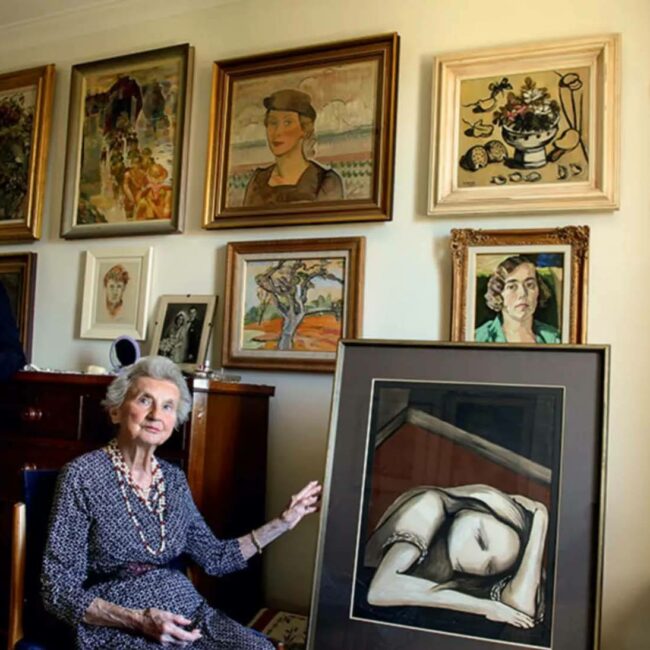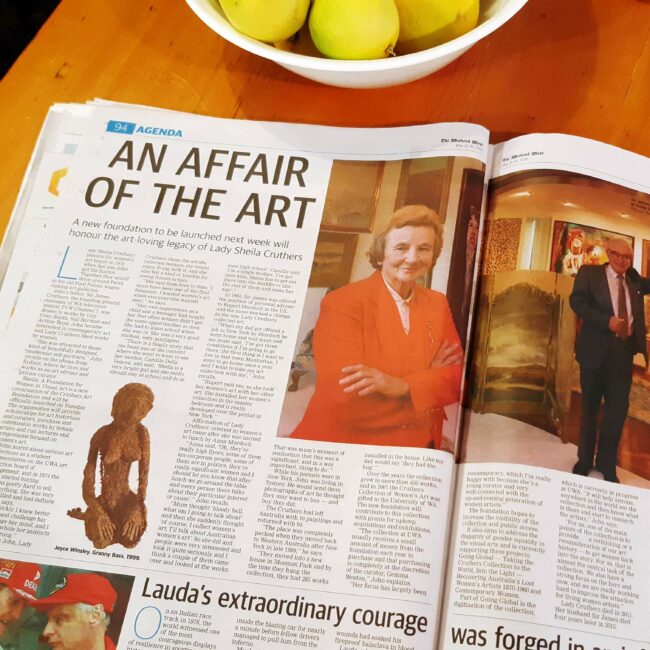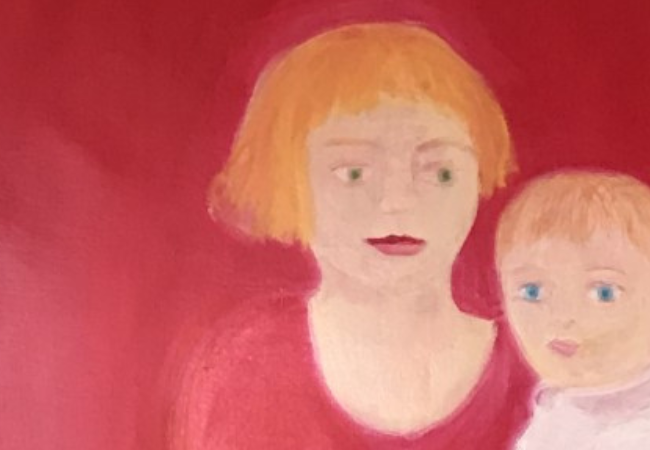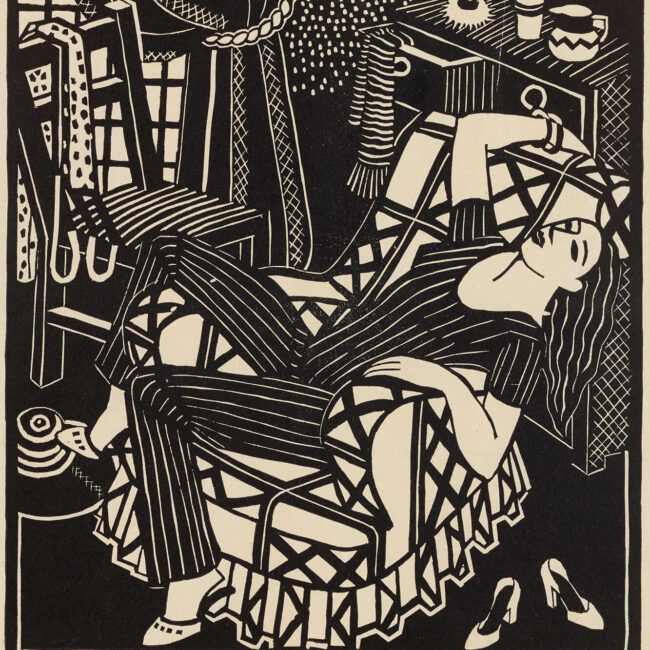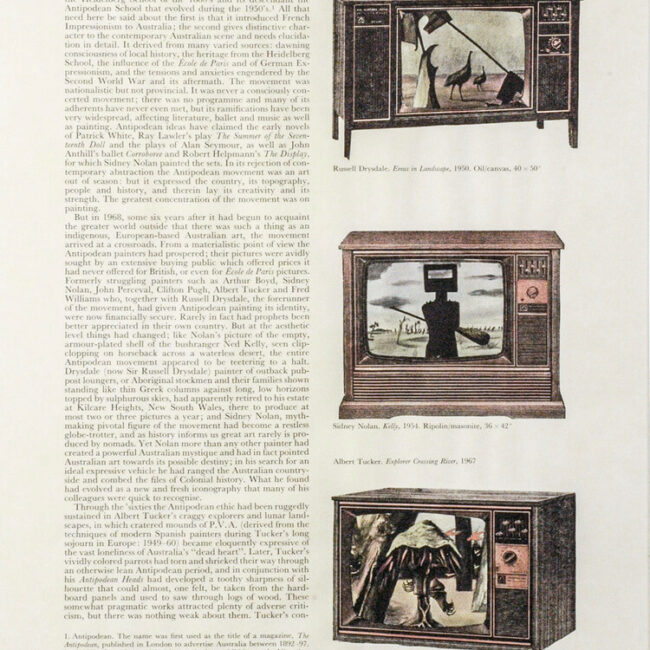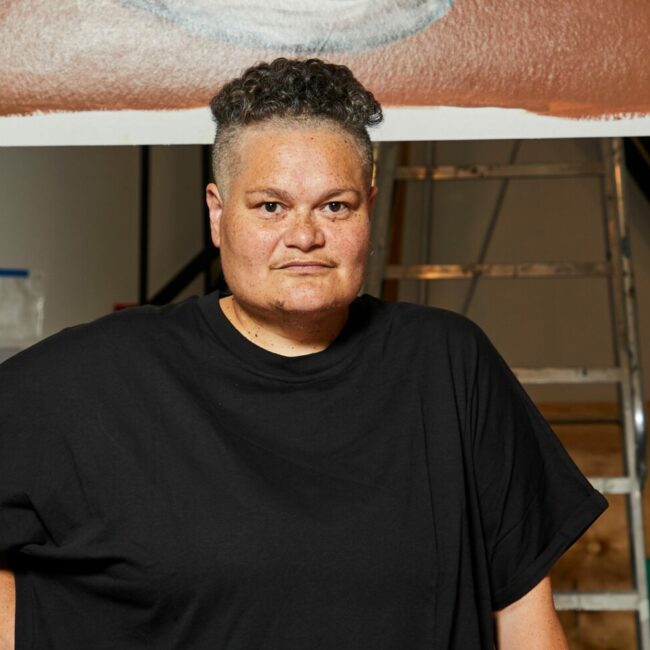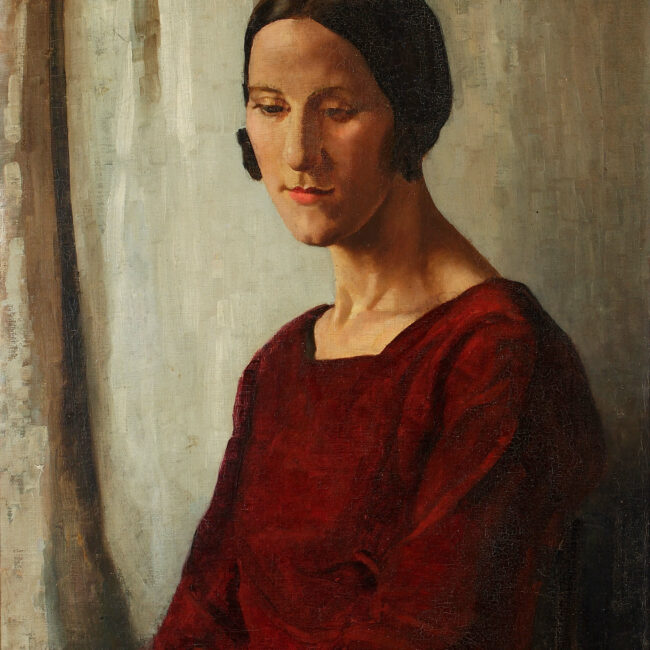As part of the broad mission of promoting women’s art, the focus of the Foundation’s blog entries will sometimes shift away from material directly based on the Cruthers Collection of Women’s Art or the activities of the Foundation and onto wider topics – a single artist or event or artwork or, in this case, a book review.
Books about women artists are useful on many fronts: making hidden or obscure information permanently available for collectors, curators and students, from both schools and universities, documenting unfamiliar careers and artworks, establishing the reputation of women artists by enabling critical discussion and helping to equalise the vast imbalance in both publication and scholarly/curatorial activity between male and female artists.

Helen Grey-Smith, Forestry Dam, 1985, acrylic, 67 x 47 cm. Collection of Bankwest / Commonwealth Bank of Australia, Perth. Photograph by Simon Cowling. Courtesy Grey-Smith Estate.
Whilst publications on male and female artists face a statistical discrepancy, by number count alone, there are also perceivable differences in the manner in which women artists are written about as opposed to how authors and curators approach male artists. In a specifically Australian context, two high profiled and much-loved authors – Rosalind Hollinrake and Drusilla Modjeska – have set a tone in which (especially historic) women artists’ careers are also embedded in a narrative of emotional drama and the artists are often ironically detached from the context of the concurrent artmaking and art theories around them. Certainly the artworld of their contemporaries often simultaneously nurtured women artists and passed over them with scant attention, but today often women artists are discussed in a vacuum, without consideration of their professional peers or acknowledging other scholarship that touches upon them. In thinking of how readers and gallery visitors in Australia learn about women artists, the ongoing impact of Rosalind Hollinrake’s spectacular rehabilitation of Clarice Beckett, and the popularity of Drusilla Modjeska’s books on women artists with the general public and book groups can not be underestimated. Hollinrake has produced a major book and a touring exhibition of Beckett’s work. Her rescue of Beckett’s paintings from a country shed is a defining moment of Australian art history in the public eye. Modjeska’s fiction is also a key popular influencer around the history of women artists given that a number of real life creative women, both Australian and international, feature in her fiction/docudramas from 17th century artist Artemisia Gentileschi to Grace Cossington Smith of Sydney.
On occasion authors writing on women artists consciously seek to replicate aspects of Hollinrake and Modjeska’s practice, or the excitement that unfolded around the two iconic surveys of historic women’s art in the 1970s, those by Janine Burke at the Ewing and Paton Galleries and Women’s Images of Women at the Art Gallery of New South Wales. Thus arises the theme of writing women artists’ biographies as a sort of personal quest which also involves the writer, or the vast tranche of biographies where the writer is often a friend or even a relative of the subject. In some cases these biographies are self-published. Male artists, by contrast, are often examined by authors in a more dispassionate and business-like tone. Is this good or bad? Does this emotionally inflected manner of writing represent an alternative or a dissonance? Are we forced to echo the lament of Margaret Atwood’s character Offred: “You wanted a women’s culture … Well, now there is one. It isn’t what you meant, but it exists.”
In this context, John Cruthers presents a review of a recent monograph covering the life of an important Western Australian woman artist who made a significant contribution to bringing contemporary culture and design to mid century Western Australia, and in establishing a radical painted response to the West Australian landscape. For those readers outside Western Australia, Helen Grey-Smith is doubly sidelined as both regional and female and this study will establish her more vividly in public memory.
By Juliette Peers
HELEN GREY-SMITH
Gwen Phillips
UWA Publishing, December 2016
RRP $55
Most books tell stories, but some books are stories. Gwen Phillips’ monograph on Western Australian artist Helen Grey-Smith is one such. Author and subject met on a long bus trip from the south west town of Pemberton to Perth in the early 1990s. As Phillips recounts in her introduction: “I was greatly impressed by her presence. She was a working artist with a lively and cultivated mind. She had lived through fascinating times, of the British Raj in India, life in an English boarding school, design training in London and then working in England during World War II. In the 1950s to 1970s, she and her husband were very prominent in the visual arts scene in Western Australia, living at Darlington then later at Pemberton, which is where I met her.”
While on secondment to the Art Gallery of Western Australia as a teacher in 1993, Phillips began to research the Grey-Smiths. A short time later she began a Master of Education degree at Edith Cowan University, which became a study of Helen Grey-Smith, based on long conversations recorded with the artist in her kitchen in Pemberton.
Her M. Ed thesis is the basis of this book, and it’s a book bounded at one end by female companionship and at the other by serendipity. When it came time to find a publisher, Phillips was equally guided by fortune, approaching UWA Publishing which, in 2012, had released Andrew Gaynor’s monograph on Helen’s husband Guy Grey-Smith. Being able to book-end this publication with one on the pioneer modernist’s wife and her work must have been irresistible to the publisher.
The opportunity to hear Helen Grey-Smith’s story in her own words in one of the book’s chief attractions. Stretching back on each side, Helen’s family were well off, industrious and religious. “They read the Bible every day,” she remembered. Her parents were English expatriates in India, where the colours and sights made a strong impression on the child Helen. At eight she was sent to boarding school in England, where she became Head Girl.
In 1937 she began studying interior design, considered a safer option for a young woman than being an art student, although it was to be a fateful choice. She was aware that her own training, in design, did not equip her to be an artist and work in oil paint.
In the late 1930s she met and married Guy Grey-Smith, a Western Australian born pilot for the RAF. But when Guy was shot down over Germany there was a long separation. Helen worked in a factory, which opened her eyes to the lives of ordinary working people. It was to be a revelation. After a prisoner exchange in 1944, Guy began art tuition and discovered his vocation as a painter. Once together, they set up home in Chelsea as Guy studied at the Chelsea School of Art and Helen became a housewife.
On their return to Australia in November 1947 they moved into a war service house in the Perth hills. As her husband built his studio and his career, Helen gave birth to their two children. Eighteen months in the UK followed, where Helen learnt textile printing. Back inPerth in 1955, the children were old enough for school and Helen resumed her art practice.

Helen Grey-Smith, Palm Trees, 1960s, screen-print on cotton, design 25 x 20 cm. Collection of Grey-Smith Estate. Photograph by David Porter. Courtesy Grey-Smith Estate.
Over the next decade she built a career and a business as a textile designer and printer. Using simplified forms derived from nature and printed using silkscreen techniques, she made long lengths of material for curtains, clothing, upholstery and other applications. Much of her work was in response to commissions, including for Perth Council House (500 yards), the Reserve Bank of Australia (commissioned by Dr Nugget Coombs), University House at the University of WA (600 yards) and the Meerilinga Children’s Foundation. She and Guy printed it all themselves, by hand, in their small studio. She also made prints she showed in joint exhibitions with Guy from 1956 to 1967.

Detail of a photo of Helen and Guy Grey-Smith working on her fabric printing. Courtesy of Richard Woldendorp.
Late in 1967 Helen suffered a setback when a repetitive strain injury in her wrist forced her to abandon the arduous physical activity of printing hundreds of metres of fabric. After a period recovering in Bali she turned to collage, and the smaller scale works that followed became the basis of the second stage of her career. She liked collage for the texture it provided to the painted surface, and because she could use the scraps from her screen-printing. Her first exhibition of collage works in 1968 was also her first exhibition of work in her own right. From that point on she worked as a painter, making several series of ambitious, larger scale works after Guy’s death in 1981. Over this period she had 12 solo exhibitions, making her one of Western Australia’s most exhibited women artists. A retrospective was staged at Curtin University of Technology Perth in 1987.
Drawing on her extensive interviews, Gwen Phillips handles Helen Grey-Smith’s life well, often using the artist’s own words to tell the story, sum up or reflect. In dealing with Helen’s art and its narrative the author is less assured, and the book shows some tension between biography and art, with the former usually having greater focus. Where space permits, the author analyses individual works well, and when Helen is quoted, as she is about the Karri Forest and Rock Pool series, there are valuable insights. But entire series – for example the Summer, Autumn and Winter landscapes shown at the Undercroft Gallery in 1979, among Helen’s major contributions to the local landscape tradition – are quickly passed over. And there is little attempt to frame a complete assessment of her work, its major themes and its place in local painting.

Helen Grey-Smith, Rock Pool, 1995, acrylic and collage, 45 x 42 cm. Private collection. Exhibited at the Old School House Gallery, Pemberton, 3 September – 3 October 1995, ‘Forest and Sea’ exhibition. Photograph by Steven Gersbach. Courtesy Grey-Smith Estate.

Helen Grey-Smith, Rock Pool, 1995 (detail). Photograph by Steven Gersbach. Courtesy Grey-Smith Estate.
Regarding the issues that presumably arose for Helen as an artist who was also a mother and the wife of a more successful artist, Phillips is guided by Helen’s own statements: “The sense of a complementary and co-operative partnership comes across very strongly in her marriage to Guy Grey-Smith…. Generosity and mutual respect lent this partnership endurance.” There is little discussion of the influence Helen and Guy may have had had on each other’s work. They often travelled together and painted the same subjects, and it is fascinating to see Helen using collage for texture in her land and seascape works while Guy made use of heavy impasto for the same reason. And yet their work could not be more different in terms of style and sensibility.

Helen Grey-Smith, The Bay, 1972, acrylic on board, 69 x 90 cm. Collection of Kott Gunning Lawyers. Photograph by David Porter. Courtesy Grey-Smith Estate.
The other dichotomy present in the book is between thesis and artist’s biography. Some of the material presumably required for academic purposes, for example the historical analysis of women’s position in the history of art, or the brief history of collage, feels out of place in what is basically an artist’s biography. In adapting the thesis for publication, these sections could have been replaced with a more consistent focus on Helen’s art and its development.
A significant point evident from the book and the companion exhibition WA Focus Helen Grey-Smith held at the Art Gallery of WA in November–December 2016, is the relative neglect the artist suffered at the hands of local collecting institutions. The Art Gallery of WA collected her printed fabrics of the 1960s, but no later collages or paintings, although a small number have been donated. As a result she’s a largely invisible figure institutionally. And yet the best paintings in the series cited above provide a revealing contrast to the better known west coast art of the post-war period, dominated as it was by the male pantheon of Helen’s husband Guy, Howard Taylor, Robert Juniper and Brian Blanchflower. As a result Western Australians will have limited opportunities to discover this artist and her subtle but distinctive interpretation of the local landscape. The book, profusely illustrated, becomes doubly important, although it’s regrettable that some of the images are not in sharp focus.

Helen Grey-Smith, Village by the Sea 3, 1972, acrylic and collage, 43.8 x 60.9 cm, Collection of Curtin University, Western Australia. Courtesy Grey-Smith Estate.
In conclusion, it may be that the strong positive impression Helen Grey-Smith made on Gwen Phillips on that initial bus trip from Pemberton was the main factor shaping this book. Phillips celebrates the artist’s qualities – her “dignified, independent, full and contented life” – as she quite justifiably should. But the respect and affection she held for her subject may have limited her ability to provide the kind of detailed analysis and objective, carefully weighed overview of her oeuvre that would have been a more telling legacy for Helen Grey-Smith’s not inconsiderable achievements.
Small quibbles aside, Gwen Phillips’ monograph is a useful addition to the selection of books on Australian women artists. More a biographical study than an artbook per se, the book allows us to hear Helen’s thoughts on her life and art, and reproduces a generous selection of works spanning her career, plus a useful summary of her exhibition history including details of individual artworks.
John Cruthers
Chair, Cruthers Art Foundation
Curatorial advisor, Cruthers Collection of Women’s Art





























